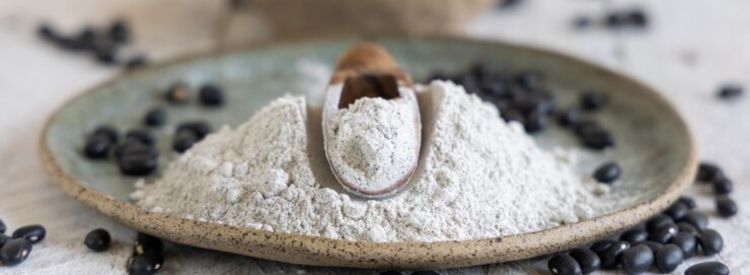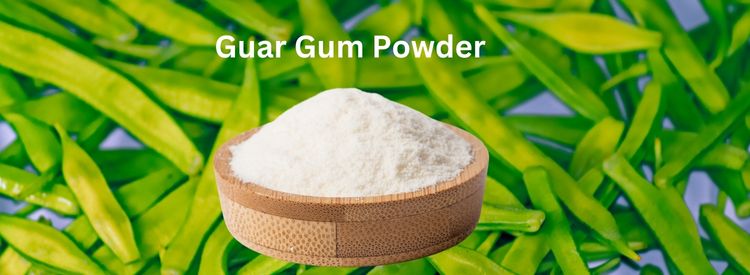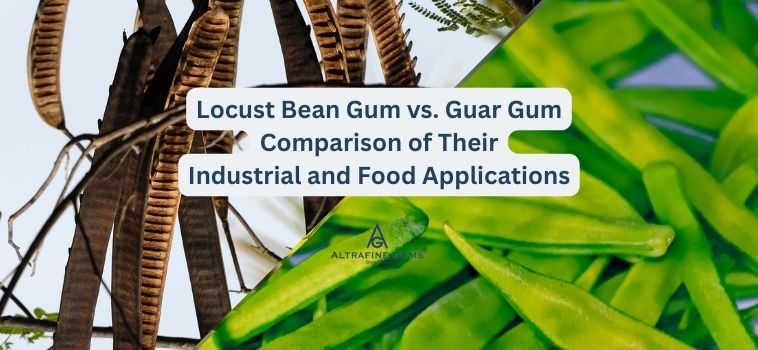Introduction: Understanding the Significance of Natural Gums in Industries
Natural gums have become indispensable in multiple industries due to their ability to stabilize, thicken, emulsify, and improve texture in food, pharmaceuticals, cosmetics, and industrial applications. Among them, Locust Bean Gum (LBG) and Guar Gum are two widely used plant-derived hydrocolloids that share several common properties but differ significantly in chemical composition, functionality, and application.
This article provides a detailed comparison of Locust Bean Gum vs. Guar Gum, analyzing their functional properties, applications in food and industry, market trends, and global demand to help manufacturers and businesses determine which gum suits their specific needs.
What is Locust Bean Gum (LBG)?
Extraction and Production Process
Locust Bean Gum is a natural polysaccharide extracted from the seeds of the carob tree (Ceratoniasiliqua), native to the Mediterranean region. The seed endosperm is mechanically separated, ground, and processed to produce LBG powder.
Key Properties and Chemical Composition
- Galactomannan polysaccharide with a higher galactose-to-mannose ratio than guar gum.
- Naturally mildly sweet with a neutral taste and odor.
- Forms viscous solutions in hot water and functions as a thickener.
- Shows synergistic gel formation when combined with xanthan gum or carrageenan.
Primary Applications in Food, Pharmaceuticals, and Cosmetics
- Food Industry: Used as a thickener, stabilizer, and gelling agent in dairy products, ice creams, baked goods, and sauces.
- Pharmaceuticals: Employed as a binder and controlled-release agent in tablet formulations.
- Cosmetics: Functions as an emulsifier and viscosity enhancer in skincare products.

What is Guar Gum?
Extraction and Production Process
Guar Gum is derived from the guar plant (Cyamopsistetragonoloba), predominantly cultivated in India and Pakistan. The seed endosperm is milled to extract the galactomannan-rich gum powder.
Key Properties and Chemical Composition
- A galactomannan polysaccharide with higher viscosity than LBG.
- Water-soluble in both hot and cold water, making it easy to use in various formulations.
- Offers better freeze-thaw stability than most other gums.
- Works as an effective thickener, emulsifier, and suspending agent.
Industrial Applications in Food, Oil Drilling, and Textiles
- Food Industry: Used in dairy, bakery, gluten-free products, and processed foods for its superior thickening and stabilizing properties.
- Oil and Gas: Essential in hydraulic fracturing (fracking) as a viscosity enhancer in drilling fluids.
- Textile Industry: Acts as a sizing agent in fabric printing and textile manufacturing.

Comparison of Functional Properties
Thickening and Gelling Ability
- Guar Gum: Higher viscosity, effective at low concentrations (0.2%-0.5%).
- LBG: Lower viscosity than guar gum, but stronger gelling ability when combined with xanthan gum or carrageenan.
Water Retention and Solubility
- Guar Gum: Cold and hot water-soluble, making it easier to use in instant products.
- LBG: Requires heat activation for full solubility.
Shelf-Life Enhancement and Stabilization
- Guar Gum: Better freeze-thaw stability, preventing ice crystal formation in frozen foods.
- LBG: Superior stability in dairy applications, reducing syneresis (water separation).
Food Industry Applications: Which Gum is Better?
Ice Cream, Dairy, and Bakery Applications
- Guar Gum is widely used in ice cream and dairy because of its better freeze-thaw stability.
- LBG is preferred in premium ice cream formulations due to its smooth mouthfeel and synergistic effect with carrageenan.
Meat Products and Processed Foods
- Guar Gum enhances water retention and improves texture in processed meats, sausages, and gravies.
- LBG is used in low-fat meat products as a fat replacer and stabilizer.
Gluten-Free and Vegan Food Products
- Guar Gum is a key ingredient in gluten-free baking, providing elasticity similar to gluten.
- LBG also functions as a binding agent in gluten-free formulations but is less commonly used than guar gum.
Industrial and Pharmaceutical Uses
Role in Cosmetics and Personal Care Products
- Guar Gum is a key ingredient in shampoos, conditioners, and lotions, providing thickening and conditioning properties.
- LBG is commonly used in high-end skincare formulations to improve texture and emulsification.
Pharmaceutical Formulations and Medicinal Benefits
- Guar Gum: Used as a binder, disintegrant, and controlled-release agent in pharmaceuticals.
- LBG: Functions as a tablet binder and natural laxative in herbal medicine.
Market Trends and Global Demand
Key Producers and Consumer Markets
- Guar Gum: Primarily produced in India and Pakistan, with major exports to the USA, Europe, and China.
- LBG: Sourced mainly from Mediterranean countries, with a strong presence in the European food industry.
Price Comparison and Economic Feasibility
- Guar Gum: Generally cheaper and more abundant, making it an economical choice for large-scale industries.
- LBG: More expensive due to limited availability and labor-intensive extraction.
Which Gum Should You Choose? – A Final Verdict
The choice between Locust Bean Gum and Guar Gum depends on specific industry needs:
- If you need a highly effective thickener with versatile applications in food, oil drilling, and pharmaceuticals, Guar Gum is the better option.
- If you are in the premium dairy, high-end cosmetics, or gluten-free niche, LBG offers unique texture-enhancing properties.
Both gums have distinct advantages, and in many applications, they are used together for synergistic effects.
Frequently Asked Questions (FAQs) – Locust Bean Gum vs. Guar Gum
Which is more cost-effective: Locust Bean Gum or Guar Gum?
Guar Gum is more cost-effective due to its higher availability and lower production cost, whereas LBG is more expensive and typically used in specialized food applications.
Can Locust Bean Gum and Guar Gum be used together?
Yes, they are often blended in food formulations, particularly in ice creams and dairy products, to improve texture and stability.
Which gum is better for gluten-free baking?
Guar Gum is the preferred choice for gluten-free baking, as it enhances dough elasticity and improves texture in bread and baked goods.
Is Guar Gum suitable for vegan products?
Yes, Guar Gum is 100% plant-based and is widely used in vegan food formulations.
Which gum is more sustainable?
Guar Gum is considered more sustainable, as the guar plant grows quickly and requires less water compared to carob trees, which take years to mature.
Conclusion
Both Locust Bean Gum and Guar Gum play a crucial role in food, industrial, and pharmaceutical applications. Guar Gum offers better cost-efficiency and versatility, while LBG is favored for its superior textural properties in premium applications. The decision on which gum to use ultimately depends on product formulation requirements, budget, and availability.


